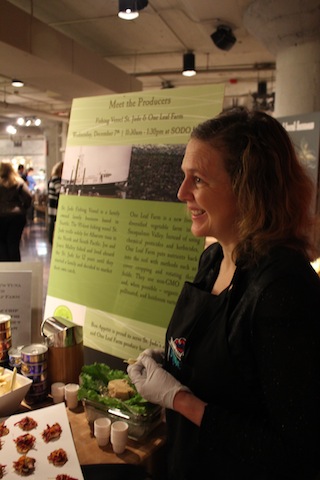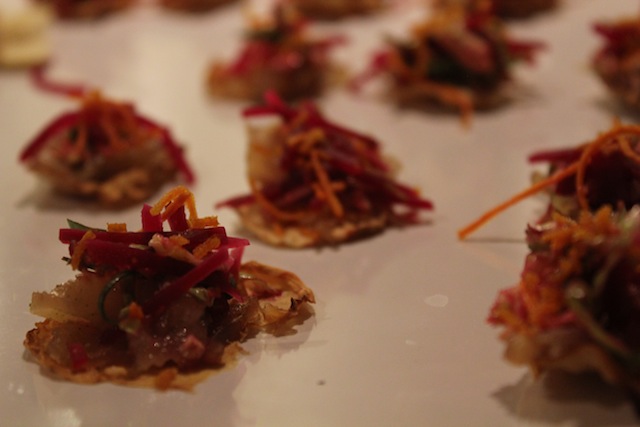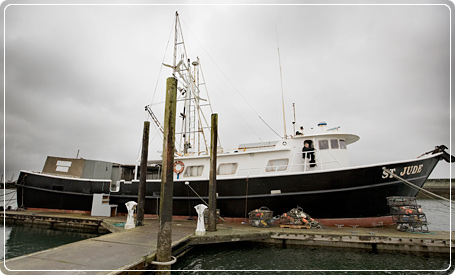Change Your Tuna: St. Jude Fishers Visits Starbucks’ SoDo Kitchen
- by Vera Chang
 For Joe and Joyce Malley, albacore tuna fishing is more than an occupation or a sport – it’s a lifelong love affair. And one they pursue thoughtfully.
For Joe and Joyce Malley, albacore tuna fishing is more than an occupation or a sport – it’s a lifelong love affair. And one they pursue thoughtfully.
Recently I got to spend the afternoon with Joyce and learn the story of the fishing vessel St. Jude, one of Bon Appétit’s Fish to Fork suppliers that we are proud to support. Together we visited Bon Appétit Management Company’s beautiful new SoDo Kitchen at Starbucks’ headquarters in Seattle for a “Meet the Producer” lunchtime table.
I hate to admit it, but I’m not a big fan of tuna. Most environmentally conscious eaters aren’t. Among the reasons: 90 percent of our oceans’ largest predators, including tuna, have been fished to “near oblivion,” as citedy by Bryan Walsh in TIME, and tuna fishing has a high carbon footprint — tuna are fast and deep swimmers, so boats have to travel out far and back to catch them. Still, many people love tuna and there are ways to harvest much more responsibly than most canned tuna methods.
The majority of white-meat tuna that sits on supermarkets shelves is caught by commercial fishing boats using either longlines or purse seines. Both are on the Monterey Bay Aquarium’s Seafood Watch Guide’s “Avoid” list as environmentally destructive practices because they inevitably catch more than just albacore, hauling aboard a lot of “bycatch” — innocent marine bystanders, if you will.
Longlines, which sometimes stretch over 70 miles across the ocean, attract fish with lines of baited hooks dangling from a central line. It is one of the biggest killers of turtles, which get hooked nibbling on longline bait, can’t return to the surface to breathe, and drown. This method is also responsible for killing sharks and albatross and other seabirds, which mistakenly dive on the glinting hooks thinking they’re fish.
Purse seines are large walls of netting that encircle school of fish, constrict the opening from above like a purse, and haul thousands of pounds of fish at a time onto the vessel. Purse seines encircle not only schools of tuna but also other types of fish, dolphins, sharks, and sea turtles. Dolphin populations have yet to recover from purse seining, and there’s currently no international law to reduce bycatch. This is why the term “dolphin-safe tuna” has fallen out of fashion – because it isn’t true.
Joe Malley started out salmon trolling in Sitka, Alaska in 1978. Joe and Joyce have fished and lived aboard the St. Jude for 12 years until they started a family and decided to market their own catch.
On the 95-foot St. Jude, the Malleys troll exclusively for albacore tuna in the North and South Pacific, a species and fishery combination listed as a “Best Choice” on the Monterey Bay Aquarium’s Seafood Watch guidelines. While trolling (not to be confused with trawling, or using a vessel to drag a large wide-mouthed fishing net along the bottom or middle of the ocean), the St. Jude moves slowly – about the speed of a golf cart – through the ocean and uses the hook-and-line method to catch tuna, considered more environmentally responsible because it targets the species and limits bycatch. Fishing lines are reeled in soon after the fish takes bait, meaning the crew can quickly release unwanted catch from their hooks if necessary. Trolling also happens at the surface of the water (the physics of the equipment prevent the lines from going deeper), so it doesn’t harm the ocean environment below.
 Back at Starbucks’ SoDo Kitchen, guests eagerly sampled Catering Chef Royal Gunter’s St. Jude albacore tuna carpaccio, served on a One Leaf Farm celeriac chip with a slaw of pickled winter beets and brussels sprouts, as they chatted about the state of our oceans, sustainable seafood alternatives, and Bon Appétit’s Fish to Fork program. It’s good to spread the message that if you eat tuna, there are ways to do so responsibly. Choose products from individually owned and operated boats that present a reliable system of traceability, and follow the Seafood Watch guidelines. Don’t buy from boats that take too many fish out of our oceans.
Back at Starbucks’ SoDo Kitchen, guests eagerly sampled Catering Chef Royal Gunter’s St. Jude albacore tuna carpaccio, served on a One Leaf Farm celeriac chip with a slaw of pickled winter beets and brussels sprouts, as they chatted about the state of our oceans, sustainable seafood alternatives, and Bon Appétit’s Fish to Fork program. It’s good to spread the message that if you eat tuna, there are ways to do so responsibly. Choose products from individually owned and operated boats that present a reliable system of traceability, and follow the Seafood Watch guidelines. Don’t buy from boats that take too many fish out of our oceans.
And if you’re in the Puget Sound area and have a hankering for albacore, St. Jude is a great boat to support. They harvest responsibly, and I have to say – have a delicious product. You can find their product at Bon Appétit Seattle cafés, local retailers, and the farmers market.
